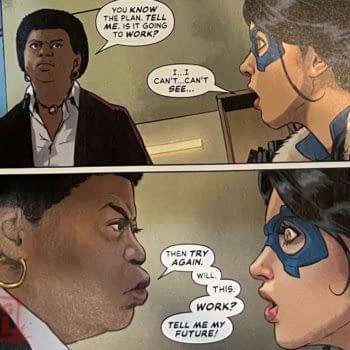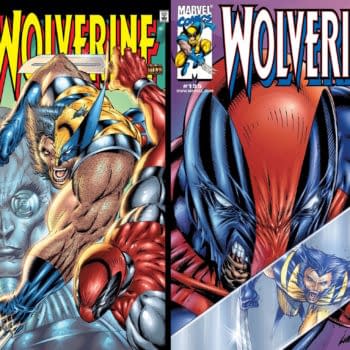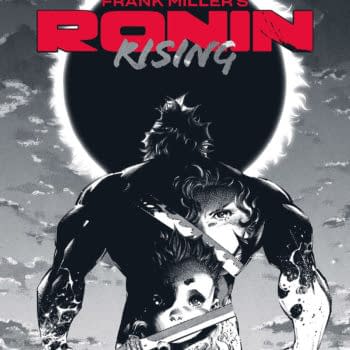Posted in: Comics | Tagged: Comics, dc, entertainment, gender, gendercrunching, marvel
Gendercrunching 2011 by Tim Hanley
Tim Hanley gendercrunches for Bleeding Cool. He is our sexual statistical correspondent.
December was a fairly average month at DC and Marvel, though DC hit some impressive new lows and Marvel fell to single digits overall for the first time since the summer. Also, there are a ridiculous number of charts as we look at 2011 in review.
DC COMICS
The overall total was decent but the breakdowns were pretty bad at DC this month. In December 2011, DC Comics released 83 new books featuring 646 credited creators, 574 men and 72 female. Here are their stats:
Their overall average was down just 0.1% from November, which is a negligible drop. Almost everything fell in December, actually, but by small amounts. Only writers (+1%) and assistant editors (+2.1%) went up. Most notably, no women drew anything on the inside of any of DC's comics this month. November's percentages for pencillers and inkers were tiny, but at least there was something. This was the first time all year that DC's had no female interior artists.
MARVEL COMICS
Marvel ended their double digit streak, and they were so close too. In December 2011, Marvel put out 85 new comics with 735 credited creators, 663 men and 72 women. Let's look at their numbers:
That's an overall drop of 1.7% from November, which is pretty steep. It seemed like a lot of their books were rushed this month to get out on time, with multiple pencillers and inkers (usually all men). All of these additional fellows might be part of the reason Marvel slid down so far. By category, there were a lot of significant drops: cover artists (-3.3%), pencillers (-1.7%), inkers (-3.8%), and editors (-10.6%… wow) all fell by notable amounts. Writers were down a tiny 0.1%, while colourists and assistant editors both jumped a few percentage points.
2011 IN REVIEW
With a year's worth of stats accumulated, we can now look book at 2011 as a whole and see how things have changed over the year. Let's start with DC, and take a look at their stats for all of 2011. DC published 958 comics with 8050 credited creators, 7160 men and 890 women:
DC's been solidly in the 11% range all year, so their overall total is no surprise. Editorial is fairly strong, of course, carrying most of the load, with colorists helping out as well. Female writers, pencillers, and inkers are tiny but again, not a shock. It's fun to have a benchmark, but these numbers don't tell us much we don't already know, so let's look at them differently.
The following charts cover EVERYTHING from 2011. It's every number for female creators from every month from every category. Most importantly, these 9 charts have trendlines so we can see what's happened over the course of the year. A trendline, for those of you who might not know, is a line that depicts how a series of numbers has changed over time. Basically, it shows us what the trend is. If the line is going up then things have improved, and down is bad. The steepness of the line shows just how much it's improved/declined.
BORING DETAILS: Each category is charted with its average total as its center line on the Y-axis. With every chart set up relative to its average, the trendlines of the various charts can be compared to each other. For example, if we put the numbers on the same chart layout we use each month, you'd barely even see a category like "Inkers" and it would look like there was no change there. But with each chart relative to its own average, we can look at the performance of each category on its own, and compare all the trendlines. SUFFICE IT TO SAY: The trendlines as presented in these charts are directly comparable to each other.
So here are all of the numbers for DC's female creators in 2011… you might want to click it to make it bigger:
DC's overall total is about as straight as a trendline can be. It's kind of impressive, actually. DC's been remarkably consistent in 2011, and there's been no real change overall for female creators. Which shouldn't come as too much of a surprise, since there's been no real change for 15 years. But by category, there's been a lot going on.
It looks like the categories that trended down did so at a steeper rate than those that went up. Pencillers, inkers, and letterers all declined at a relatively steep angle, while colorists and cover artists angled down at a slightly more leisurely pace. Overall, 5 of the 8 categories were on a downward slope.
Writers, editors, and assistant editors all trended up, but very slightly. The editorial numbers were fairly consistent, with a bit of growth overall, while the writers' rollercoaster of a year was less consistent but amounted to a net positive change.
Altogether, in 2011 DC declined more than it rose by category. It's a little disheartening that while several categories declined sharply, nothing really rose dramatically elsewhere. The best DC had in 2011 was a few areas of incremental gains, which isn't much to be excited about.
Now onto Marvel. Marvel released 1087 new comics in 2011, featuring 9276 credited creators, 8391 men and 885 women. Here are their averages for the year:
Seeing as Marvel's overall percentage was in the 8% range for several months, a total of 9.5% for the year isn't so shabby for them. Marvel is the opposite of DC in a lot of ways… their editorial numbers are lower, but generally speaking their creative numbers are higher. Marvel has a lower overall total, but the work gets spread around a bit more.
Let's look at their massive wall of charts for trends:
Marvel's overall total trended upwards in 2011, and while the line isn't terribly steep, it's not exactly slight either. They had a solid jump this fall, and the net result was some decent growth for the year.
In terms of categories, Marvel was evenly split with four trending down and four trending up. Assistant editors trended downward every so slightly in 2011, while cover artists and writers declined at a steady but not terribly steep rate. Letterers, however, trended down so bad that the line didn't even fit the parameters of the graph. That's what happens when you have one letterer in January and then no more for the rest of the year I guess.
Pencillers and inkers trended up at a moderate rate, while colorists went up even more so. The biggest change for the year was for editors, which grew at a relatively steep angle. While the pencillers and inkers' totals were a little all over the place this year, you can really see consistent improvement when you look at the colorists and editors' charts.
All in all, Marvel had an interesting 2011. They trended up overall, which is nice to see, and things seemed to balance out by category with some growth and some declines. Altogether, things at Marvel moved in a slightly positive direction over the course of 2011.
DC and Marvel both had their positives and negatives in 2011. DC had better numbers overall, but no real growth and some steep declines by category. Marvel grew in a positive direction in 2011, but their overall numbers were still lower. Can no one have high numbers AND growth?? I'd really like to see that in 2012, please.
NOTES:
To learn more about this statistics project and its methodology click here, and to see the previous stats click here.
You can visit Tim at Straitened Circumstances and follow him on Twitter @timhanley01.


















